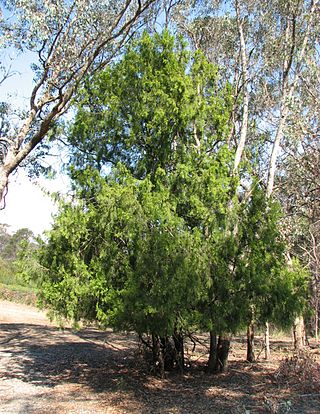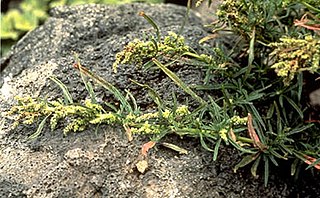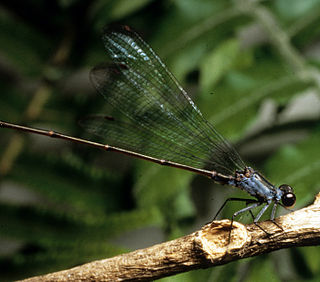
The Laysan duck, also known as the Laysan teal, is a dabbling duck endemic to the Hawaiian Islands. Fossil evidence reveals that Laysan ducks once lived across the entire archipelago, but today survive only on Laysan Island and two atolls. The duck has several physical and behavioral traits linked to the absence of ground-based predators in its habitat. By 1860, the ducks had disappeared from everywhere except Laysan Island. The introduction of European rabbits by guano miners at the end of the 19th century brought the bird to the brink of extinction in 1912, with twelve surviving individuals. Rabbits were eradicated from the island in 1923 and numbers of Laysan ducks began to rise, reaching 500 by the 1950s. In an effort to ensure the long-term future of this duck, 42 birds were translocated to Midway Atoll National Wildlife Refuge in 2002. These thrived in their new surroundings, and another group were later relocated to Kure Atoll.
Hawaiian hibiscus are seven species of hibiscus native to Hawaii. The yellow hibiscus is Hawaii's state flower. Most commonly grown as ornamental plants in the Hawaiian Islands are the non-native Chinese hibiscus and its numerous hybrids, though the native Hibiscus arnottianus is occasionally planted.

Abutilon menziesii, known as Koʻoloaʻula in Hawaiian, is an endangered species of flowering shrub in the family Malvaceae, that is endemic to Hawaii.

Exocarpos is a genus of flowering shrubs and small trees in the sandalwood family, Santalaceae. They are found throughout Southeast Asia, Australia and the Pacific Islands.

Amaranthus brownii was an annual herb in the family Amaranthaceae. The plant was found only on the small island of Nihoa in the Northwestern Hawaiian Islands, growing on rocky outcrops at altitudes of 120–215 m (394–705 ft). It was one of nine species of Amaranthus in the Hawaiian Islands, as well as the only endemic Hawaiian species of the genus. It is now considered extinct.

The Kauaʻi cave wolf spider, also known to local residents as the blind spider, is only known to occur in a few caves in a lava flow with an area of 10.5 km2 (4.1 sq mi) in the Kōloa–Poʻipū region of Kauaʻi, Hawaiian Islands, and only six populations are known to exist. While their nearest surface-dwelling relatives have large eyes, this species has completely lost its eyes. They reach a body length around 20 mm (0.8 in), and are reddish brown and completely harmless to people. Unlike most wolf spiders, it produces only 15 to 30 eggs per clutch. The female carries the egg sac in her mouthparts until the spiderlings hatch.

The Mauna Loa silversword, Argyroxiphium kauense, or Kaʻū silversword, is a rare species of flowering plant in the aster family. It is endemic to the eastern and southern slopes of Mauna Loa on the island of Hawaiʻi. A. kauense occurs in mountainous shrublands, bogs, and open mesic forest. The species is managed by the National Park Service and Hawaiʻi State Department of Forestry and Wildlife. It is a federally listed endangered species of the United States. There are three known populations remaining, for a total of fewer than 1000 individuals.

Bidens amplectens, the Waiʻanae kokoʻolau, is a species of flowering plant in the family Asteraceae. It belongs to the genus Bidens, collectively called kokoʻolau or koʻokoʻolau in the Hawaiian language. It is found in coastal and dry lowland habitats in the Waiʻanae Range on Oʻahu. It is threatened by habitat loss due to the spread of invasive weeds and brush fires. The species is also threatened by climate change and habitat degradation, and herbivory. Bidens amplectens is currently listed as endangered under the Endangered Species Act.

Megalagrion nesiotes is a species of damselfly in the family Coenagrionidae. Its common name is flying earwig Hawaiian damselfly. In the past, the flying earwig Hawaiian damselfly lived on the islands of Hawaii and Maui, in the U.S. state of Hawaii. Currently, there is only one population left in east Maui. Limited distribution and small population size make this species especially vulnerable to habitat loss and exotic species invasion. The flying earwig Hawaiian damselfly was last found in 2005. Little is known about this species because of the lack of observation. In 2010, the species was federally listed as an endangered species in the United States.

Amsonia kearneyana is a rare species of flowering plant in the dogbane family known by the common name Kearney's bluestar. It is native to Arizona, where there is only one native population in the Baboquivari Mountains of Pima County. There may also be a population just south of the border in Sonora, Mexico. The plant was federally listed as an endangered species in 1989. At that time the global population of the plant was made up of eight individuals in a riparian canyon. Since that time the plant has been manually propagated in an attempt to increase its numbers. Threats to the tiny native population include habitat destruction from livestock activity and flash floods in the river canyon. Many of the plants cannot reproduce because their seeds are sterile and nonviable, but this is probably due to insect predation on the seeds as they develop.

Leichhardtia suaveolens, synonym Marsdenia suaveolens, commonly known as the scented milk vine, is a small vine found in New South Wales, Australia. It is found in a variety of habitats in relatively high rainfall areas, from Bega to Port Macquarie. The original specimen was collected at Sydney on 11 May 1802.

Castilleja levisecta is a rare species of flowering plant in the family Orobanchaceae known by the common name golden paintbrush, or golden Indian paintbrush, listed under the Endangered Species Act in 1997. It is native to British Columbia and Washington, where it is known from eleven remaining populations. It occurred in Oregon but all natural occurrences there have been extirpated. It has been reintroduced to a few areas in Oregon, but it remains to be seen if the plants will survive. The plant is a federally listed endangered species of Canada and was listed as threatened in the United States in 1997. On June 30, 2021, the plant was proposed for delisting due to recovery. Effective August 18, 2023, the U.S. Fish and Wildlife Service issued a rule removing golden paintbrush from the Federal List of Endangered and Threatened Plants
Exocarpos luteolus is a rare species of flowering plant in the sandalwood family known by the common names leafy ballart or heau. It is endemic to Hawaii, where it is known only from the island of Kauai. There are eight populations remaining, for a total global population of only 39 individuals. The plant was federally listed as an endangered species of the United States in 1994.
Neoendemism is one of two sub-categories of endemism, the ecological state of a species being unique to a defined geographic location. Specifically, neoendemic species are those that have recently arisen, through divergence and reproductive isolation or through hybridization and polyploidy in plants. Paleoendemism, the other sub-category, refers to species that were formerly widespread but are now restricted to a smaller area.
Drosophila hemipeza is an endangered species of Hawaiian fly in the family Drosophilidae. This species is a member of the planitiba subgroup of the picture-wing clade of Hawaiian Drosophila.
Drosophila aglaia is an endangered species of fly from Hawaii. This species is a member of the aglaia subgroup of the picture-wing clade of Hawaiian Drosophilidae. It is only found on the island of Oahu, and has not been observed since 1997, when it was found in Palikea.
Drosophila obatai is an endangered species of fly from Hawaii, in the species rich lineage of Hawaiian Drosophilidae. It is only found on the island of Oahu. D. obatai is part of the orphnopeza subgroup in the picture-wing clade, and is closely related to D. sodomae, a fly found on the islands of Maui and Molokai.
Drosophila substenoptera is an endangered species of fly in the species rich lineage of Hawaiian Drosophilidae. It is only found on the island of Oahu,. Historically it was collected throughout the Ko'olau and Wai'anae ranges, but now is only known to occur near the summit of Mt. Kaala. D. substenoptera is a member of the planitibia species group and neopicta subgroup within the picture-wing clade.
Drosophila differens is an endangered species of Hawaiian fly in the family Drosophilidae. This species is a member of the planitiba subgroup of the picture-wing clade of Hawaiian Drosophila. It is found on the island of Molokai.
Drosophila digressa is an endangered species of fly from Hawaii, in the species-rich lineage of Hawaiian Drosophilidae. It is only found on the Big island of Hawaii. It was historically known from sites throughout the islands, but is now restricted to the Manuka and Ola'a reserves.















